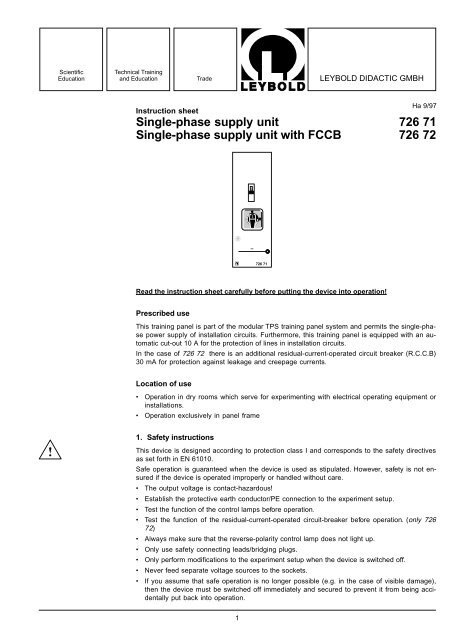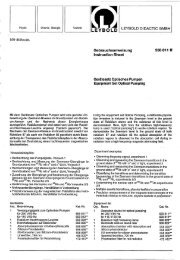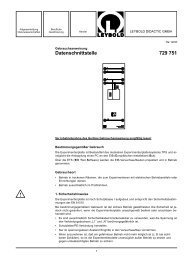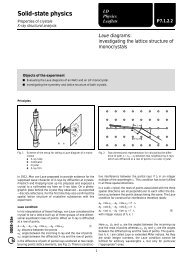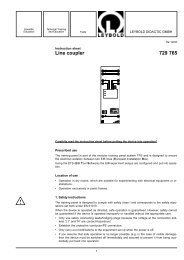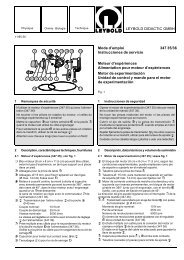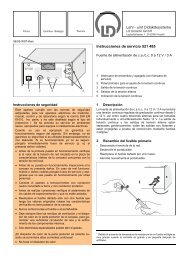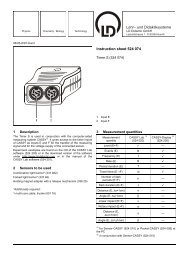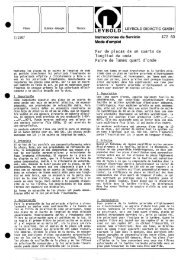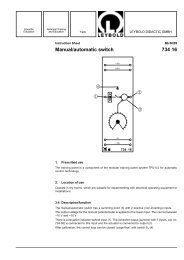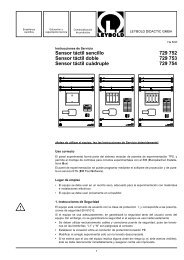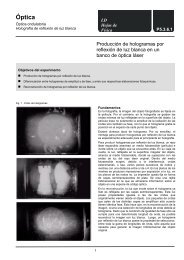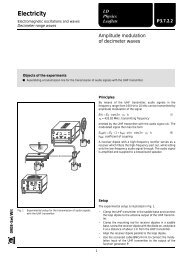Single-phase supply unit 726 71 Single-phase ... - LD DIDACTIC
Single-phase supply unit 726 71 Single-phase ... - LD DIDACTIC
Single-phase supply unit 726 71 Single-phase ... - LD DIDACTIC
You also want an ePaper? Increase the reach of your titles
YUMPU automatically turns print PDFs into web optimized ePapers that Google loves.
Scientific<br />
Education<br />
Technical Training<br />
and Education Trade LEYBO<strong>LD</strong> <strong>DIDACTIC</strong> GMBH<br />
Instruction sheet<br />
Ha 9/97<br />
<strong>Single</strong>-<strong>phase</strong> <strong>supply</strong> <strong>unit</strong> <strong>726</strong> <strong>71</strong><br />
<strong>Single</strong>-<strong>phase</strong> <strong>supply</strong> <strong>unit</strong> with FCCB <strong>726</strong> 72<br />
Read the instruction sheet carefully before putting the device into operation!<br />
Prescribed use<br />
This training panel is part of the modular TPS training panel system and permits the single-<strong>phase</strong><br />
power <strong>supply</strong> of installation circuits. Furthermore, this training panel is equipped with an automatic<br />
cut-out 10 A for the protection of lines in installation circuits.<br />
In the case of <strong>726</strong> 72 there is an additional residual-current-operated circuit breaker (R.C.C.B)<br />
30 mA for protection against leakage and creepage currents.<br />
Location of use<br />
• Operation in dry rooms which serve for experimenting with electrical operating equipment or<br />
installations.<br />
• Operation exclusively in panel frame<br />
1. Safety instructions<br />
This device is designed according to protection class I and corresponds to the safety directives<br />
as set forth in EN 61010.<br />
Safe operation is guaranteed when the device is used as stipulated. However, safety is not ensured<br />
if the device is operated improperly or handled without care.<br />
• The output voltage is contact-hazardous!<br />
• Establish the protective earth conductor/PE connection to the experiment setup.<br />
• Test the function of the control lamps before operation.<br />
• Test the function of the residual-current-operated circuit-breaker before operation. (only <strong>726</strong><br />
72)<br />
• Always make sure that the reverse-polarity control lamp does not light up.<br />
• Only use safety connecting leads/bridging plugs.<br />
• Only perform modifications to the experiment setup when the device is switched off.<br />
• Never feed separate voltage sources to the sockets.<br />
• If you assume that safe operation is no longer possible (e.g. in the case of visible damage),<br />
then the device must be switched off immediately and secured to prevent it from being accidentally<br />
put back into operation.<br />
1<br />
0<br />
PE<br />
1<br />
<strong>726</strong> <strong>71</strong>
Automatic<br />
circuit-breaker<br />
RCCB circuit-breaker<br />
(only <strong>726</strong> 72)<br />
Reverse-polarity control<br />
lamp<br />
2. Description<br />
1Mains switch<br />
5<br />
2<br />
0<br />
PE<br />
4<br />
1<br />
<strong>726</strong> <strong>71</strong><br />
2Residual-current-operated circuit-breaker 30 mA, (only <strong>726</strong> 72)<br />
3Automatic circuit-breaker 10 A<br />
4Phase control lamp L1,<br />
to monitor the voltage at the connection socket L1<br />
5Reverse-polarity control lamp,<br />
lights up when the mains plug is connected with the wrong polarity<br />
6Connection socket L1<br />
7Connection socket N<br />
8PE connection socket<br />
3. Operation<br />
If the automatic circuit-breaker is tripped out during overload of the experiment setup:<br />
• Disconnect experiment setup from the mains by switching the mains switch to [OFF]<br />
• Correct fault source<br />
• Reset the automatic circuit-breaker by setting the switch to [I]<br />
Test the function of the RCCB:<br />
• Set mains switch to [ON]<br />
• Press the pushbutton [T] on the RCCB circuit-breaker<br />
• If the RCCB circuit-breaker is tripped, operation is guaranteed.<br />
If the RCCB circuit-breaker is tripped by a fault current in the experiment setup<br />
• Disconnect the experiment setup from the mains by switching the mains switch to [OFF]<br />
• Correct fault source<br />
• Reset the RCCB circuit-breaker by setting the switch to [I]<br />
If the reverse-polarity control lamp lights up:<br />
• Pull out the mains plug<br />
• Replug the mains plug with the correct polarity (rotate)<br />
6<br />
7<br />
3<br />
1<br />
8
4. Technical data<br />
Mains switch: Cam switch, two-pole<br />
Connection: Connection line with earthing-pin connector<br />
Input voltage: 230 V AC, 50...60 Hz<br />
Fuses: Automatic circuit-breaker FAZ C 10 A<br />
<strong>726</strong> 72: RCCB circuit-breaker 30 mA<br />
Output: 4-mm safety sockets<br />
3


